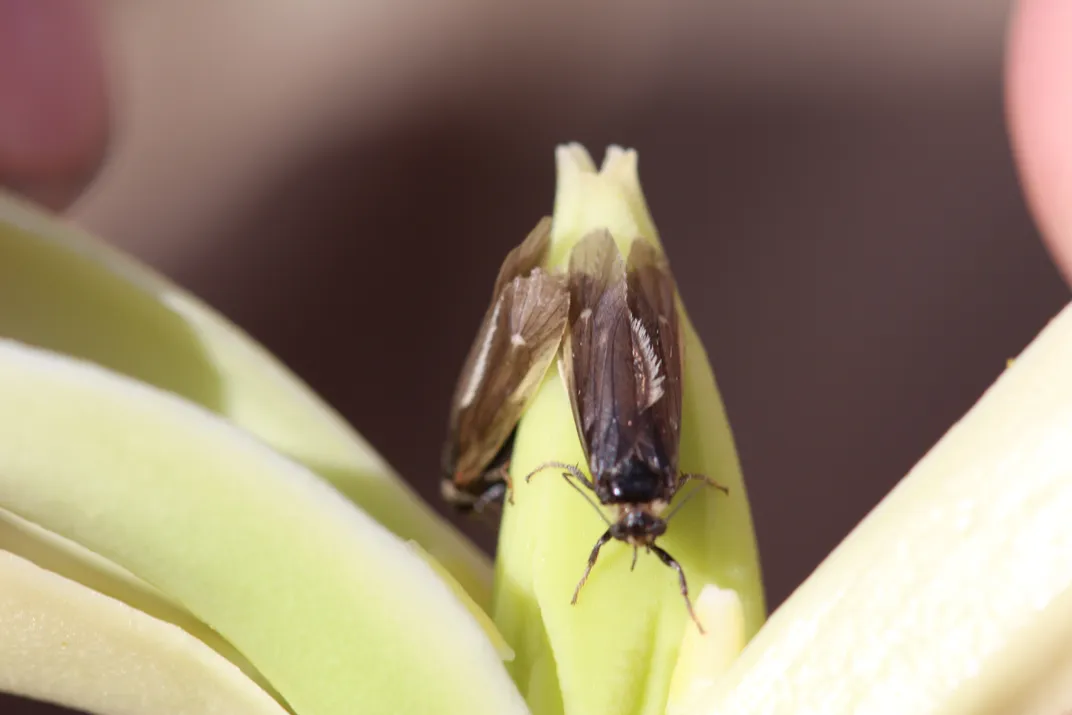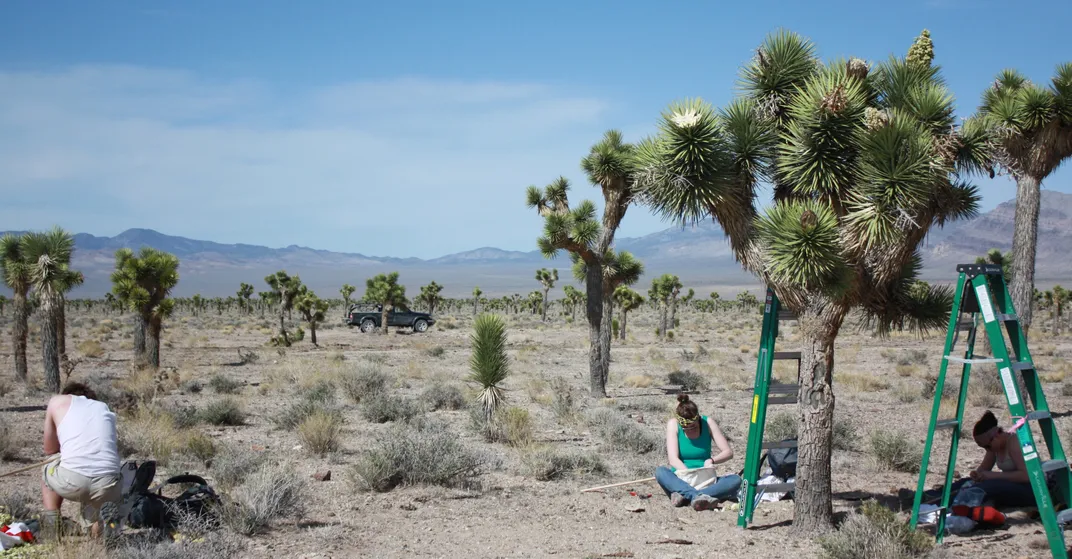How a Tree and Its Moth Shaped the Mojave Desert
The partnership between the Joshua tree and the yucca moth may be key to understanding how plants and insects co-evolve
:focal(2050x1012:2051x1013)/https://tf-cmsv2-smithsonianmag-media.s3.amazonaws.com/filer/f1/22/f122c653-60c5-41ea-8673-7c8fa8264e60/bdxe48.jpg)
Flowering plants only appear in the fossil record around 100 million years ago, and yet they comprise 90 percent of the plant kingdom. Meanwhile, around 75 percent of known animal species are insects. In Origin of Species, Charles Darwin put forth an explanation for this stunning diversity: pollination. Plants and their insect pollinators, he surmised, must evolve in conjunction with one another in a process he coined “co-evolution” until they blossom into a dazzling array of forms.
But in the vast world of plants and their pollinators, there was one example that Darwin deemed the “most wonderful case of fertilisation ever published” in a letter to botanist Joseph Dalton Hooker. This was the curious case of the Joshua tree and the yucca moth.
We’ll start with the Joshua tree, the Mojave Desert’s most iconic plant. With its spiny fronds and clubbed tufts topped by pungent, waxy flowers twisting towards the desert sky, this desert-adapted shrub has a reputation for otherworldliness. Everyone who passes through the desert remembers the majestic Joshua tree; its namesake has inspired artists, filmmakers and many a sojourner in search of transcendence.
Few travelers, however, wax poetic about its evolutionary partner, the yucca moth. The small, dun bug is initially unassuming, but upon closer inspection, it is an equally extraterrestrial match for the iconic Joshua tree. Instead of a regular mouthpiece, it sports bizarre, tentacle-like fronds, the likes of which are unique among insects—and serve an essential purpose in the desert ecosystem.
Without nectar to attract pollinators, Joshua trees rely solely on this unassuming moth for pollination. Yucca moths use their dexterous jaw appendages to collect pollen from Joshua tree flowers and deposit it on the female parts of each flower as the moth moves between blooms. In turn, the moth lays her eggs with its thin, blade-like ovipositor on the flowers’ seeds.
When they hatch, the yucca moth caterpillars eat the seeds—their only food source—before crawling to the ground to form cocoons. And the cycle begins again.
According to Christopher Smith, a biologist at Willamette University who studies pollinator relationships, the relationship between yucca moths and Joshua trees is unlike anything else in the natural world. He should know: Smith has long studied the diverse relationships between insects and plants in the desert. His previous research focused on cactus longhorn beetles and the spiny plant species they interact with throughout the Sonoran Desert. But nothing, he says, compares to the Joshua tree and the yucca moth.
Most pollinators accidentally assist the plants they pollinate. Bees and birds will brush up against pollen while they are feeding on a flower’s nectar, spreading it from plant to plant as they continue a day’s feast. Not yucca moths: because their caterpillars depend on the continued existence of Joshua trees and their tasty seeds, the yucca moth’s pollination is an active act of survival. Moreover, this partnership has been going on for millions of years.
Joshua trees do more than provide artistic inspiration: they create essential environmental support for the uncompromising desert ecosystem. These hideously beautiful shrubs provide food and shelter for animals in the Mojave scrublands, where resources are notoriously scarce. During the spring, its flowers are one of the only sources of wet food available for insects, ravens, and ground squirrels.
Yet today, their long-lived partnership may be in danger of breaking down, as the Joshua tree’s natural habitat faces new threats.

The right moth for the job
There are two distinct kinds of Joshua trees, divided by the low inland basins of Death Valley and the Amargosa Desert: bushy, short-leafed eastern Joshua trees (Yucca brevifolia jaegeriana) and arboreal, long-leafed western Joshua trees (Y. b. brevifolia). The two are so different, scientists have even advocated splitting Yucca brevifolias into two species. But what evolutionary reason is responsible for this divergence?
That, says Smith, is the “multi-million dollar question.”
Moths may hold the answer. Ecologists long believed that one species of yucca moth (Tegeticula synthetica) pollinates both kinds of Joshua trees. But in 2003, a team of scientists discovered that a genetically distinct yucca moth (T. antithetica) pollinates the eastern trees exclusively. Like the Joshua trees themselves, this moth was shorter than its western counterpart. Even more eerie, the difference in the distance between the stigma and ovule between the two tree types was the same as the difference in body size, head to abdomen, between the two moths.
“I thought, ‘That can’t be coincidence,’” Smith says.
To determine if co-evolution brought about this suspicious speciation, Smith led a team of citizen scientists in 2013 and 2014 to collect morphological data in the one spot where the two species of Joshua trees and their corresponding moths live in harmony: Tikaboo Valley.
Smith and his team observed that yucca moths deposit their eggs more efficiently in their corresponding Joshua trees, and the Joshua trees in turn provide more space for the eggs when pollinated by the prefered moth. Smith’s preliminary results also show that the moths more successfully reproduce when their body size matches the size of the stalk between the flower’s stigma and ovary, known as the style.
Though moths will pollinate flowers whose styles are too long, they almost never successfully lay eggs that hatch into caterpillars. When the styles are too short, the moths can damage the flowers with their ovipositor.
Smith points out that these correspondences don’t necessarily prove co-evolution. The Joshua trees could be evolving in reaction to something in their natural environments, and the moths could be responding, which demonstrates evolution, as one species changes in response to environmental stresses (and then the other evolves in response to the first species resonding)—but not co-evolution, where both species change reciprocally in response to one another.
To remove the potential for randomness, Smith now plans to map the genome of the Joshua trees through a collaboration called the Joshua Tree Genome Project, launched last March by Smith and six other scientists and funded through a combination of crowdsourcing and support from the Living Desert. Aside from Smith’s research, one of the primary goals of the project is to identify genes that are involved in the Joshua tree’s adaptation to climate in order to plan for the coming climate crisis.
Once he has the genomes of the two Joshua trees, Smith will compare them to the genomes of well-studied plants to determine which genes correspond to flower morphology, branch length and other characteristics. From there, he can compare the genomes of the two species of Joshua trees and determine the average variation between their alleles—sthat is, the variation due to evolution. Genes that show dramatic variation when compared to this baseline are marked for natural selection.
A key part of that strategy may be in its relationship to the yucca moths. Research already demonstrates that the differences in ovipositor length and body size in the yucca moths’ genomes are more pronounced, suggesting that natural selection has driven the discrepancy. Smith hopes to find the same for the morphology of Joshua tree flowers.

Racing the clock
But time may be running out. Joshua trees are critically threatened by climate change: as the warming climate evaporates precious water from the soil and the frequency of rain decreases, Joshua tree seedlings are less likely to survive prolonged seasons of drought than their full grown counterparts.
“A lot of times when people look at a place like Joshua Tree National Park where you see a lot of mature trees, they think it looks healthy,” says Cameron Barrows, an ecologist at the Center for Conservation Biology at the University of California at Riverside. “But if you’re not seeing the juveniles, that means the species isn’t replacing itself.”
As fewer Joshua tree seedlings survive and mature, the population dwindles, and so does the diversity of the desert. Because the Joshua tree is a keystone species in the Mojave, a number of different insects, lizards, and birds will lose important sources of habitat in, on, and under their branches.
According to Barrows’s climate models, the Mojave Desert could lose up to 90 percent of Joshua trees before the end of the century. Even in the worst-case scenarios, there are spots Barrows calls “refugia” where Joshua trees could propagate and thrive – if they stay clear of invasive weeds and wildfires – but the range is shrinking considerably.
Like many organisms, Joshua trees are migrating in response to their habitats warming by dropping their seeds further north. Right now, seedlings are growing within 100 meters of their parent plants; in order to reach areas that are cool enough to survive, they may need to move thousands of miles. Joshua tree seeds have yet to demonstrate the ability to spread so quickly.
Perhaps more essentially, neither have yucca moths. “We have no idea how the yucca moth might react to moving thousands of miles north,” Smith admits. Due the yucca moth’s brief lifespan and short interaction with Joshua trees, it is difficult to study how they will respond to such changes in their environments. Without their sole pollinators, Joshua trees will perish regardless of whether their seeds can make the journey.
Understanding these symbiotic relationships becomes even more essential when developing strategies for responding to climate change. Some scientists have suggested physically moving species threatened by climate change, but this could disrupt systems that are not yet fully understood.
“Often, conservation biologists think of mass communities as static,” says Smith. “In making conservation strategies, we need to be thinking about not just what is the system like today, but how the system will change in the future in response to the world changing.”
One thing is for certain: The loss of the Joshua tree would drastically alter the image of the Mojave Desert in the collective consciousness. Now the fate of these trees—and our ability to defend them—rests in the mouthparts of a tiny gray moth.